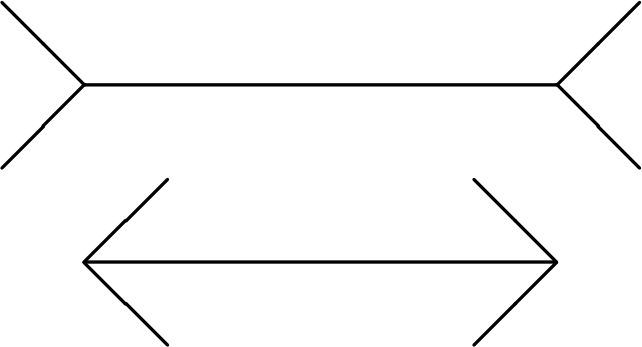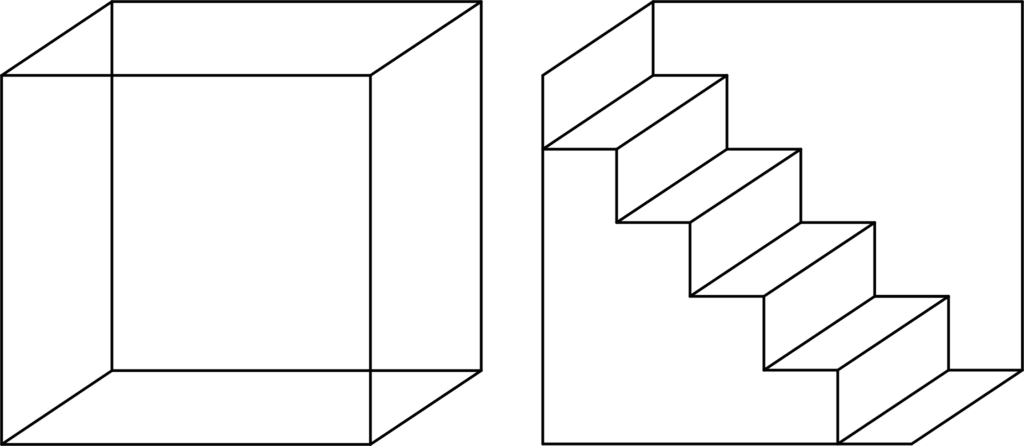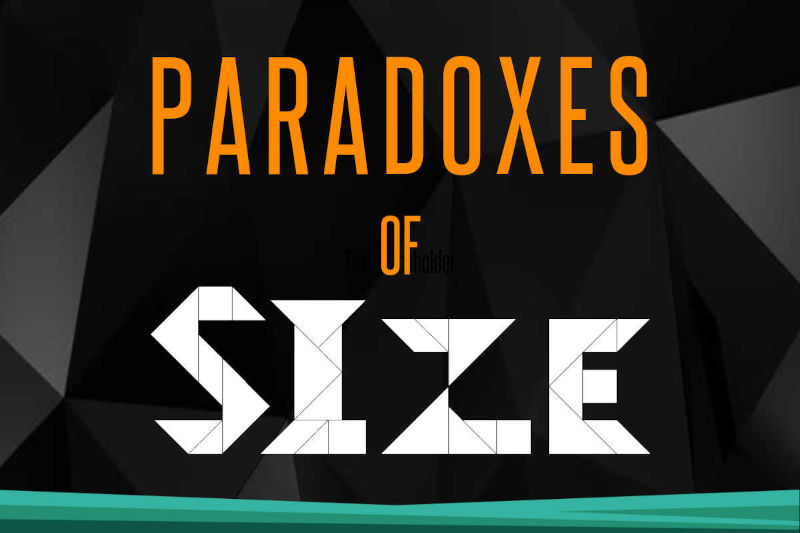
Perform Optical Illusions as Magic Tricks

Peter Prevos |
1724 words | 9 minutes
Share this content
The art of magic creates a world where expectations of the way the world functions are temporarily violated. Magicians use the fact that our mind does not perceive the world as it is to create the illusion of magic. Optical and visual illusions are nature's own magic trick as they expose how our limited perception of the world around us. Science and theatrical magic have always gone hand-in-hand. This article describes how magicians can use optical illusions as magic tricks. A previous version of this article was published in the Austrian magazine Aladin.

Optical Illusions
Imagine that you are sitting on a train. You look out the window and believe that the train is moving. You soon realise that in reality, the neighbouring wagons are moving. After your train finally leaves, you look through the back window, and it seems like the tracks physically meet in the distance, although you know with certainty that they are perfectly parallel to each other. This anecdote is examples of illusions as we experience them in everyday life.
Psychologists have studied the nature of optical illusions to understand how our brain is cheating itself. The study of these illusions also has practical implications. For example, factory control rooms contain many complicated dials and displays that help operators make correct decisions. Engineers design these instruments, so there is no misunderstanding how to interpret the information they display. Another application can be found in traffic engineering. Roads must be designed so that visual information is correctly understood by the driver to reduce the likelihood of accidents.
Optical illusions are also deliberately introduced to avoid perceptual errors. Ancient Greek architects formed stone pillars in a gentle curve with their base slightly wider than the top, so that they seem perfectly straight. Optical refinements to simulate geometric perfection are common in Doric Greek temple architecture. The Parthenon on the Acropolis of Athens is admired for its architectural perfection. To realise this perfect geometry, the architects Ictinus and Callicrates have curved almost every line in the design and created the illusion of straight lines and geometric perfection.

Scientists have systematically studied optical illusions since 1855, the year when the German psychologist Joseph Oppel published an article on the subject. Since that first publication, thousands of books and journal articles have been written on the topic.
One of the simplest illusions is the Müller-Lyer illusion. The horizontal lines have the same length, but the arrows inward or outward confuse the brain because the horizontal lines do not seem to be the same size. The German psychologist Franz Carl Müller-Lyer first published this illusion in work on fifteen geometric illusions.

The Ponzo Illusion is similar to the first example. The converging oblique lines distort our perception of identical horizontal lines. The angled lines cause our brain to recognise the upper line as slightly smaller than the lower one. This illusion is named after the Italian psychologist Mario Ponzo.

If two circles of the same diameter are surrounded by larger and smaller circles, they appear to be different in size. This deception was discovered by the German psychologist Hermann Ebbinghaus. The presence of smaller or larger objects affects our perception of size. This illusion can be used in real life to make portions of food appear smaller than they are. When a chef serves a meal on a giant plate, it seems smaller than when placed on a standard plate.

The last example here is the Poggendorff illusion, first described in 1860. In this illusion, a rectangle covers an oblique line. Although the diagonal line is straight, it seems as if the line is unequal. This illusion was designed by Johann Zöllner, but it was named after Johann Poggendorff, the publisher of the journal in which it appeared.

Although these phenomena have been studied for more than a century, the actual cause of these deceptions is still not fully certain. There are several competing explanations of how the brain causes them. However, none of these theories is universally accepted by psychologists.
Visual and cognitive illusions
Visual illusions occur when the physical circumstances outside our mind deceive us. Distortions of light in our eyes, such as the mirrors in an amusement park, cause these illusions. If you look in a curved mirror, you appear shorter, longer, thicker or thinner. Optical illusions also form the basis of the art of photography. Photographers combine focal length, aperture and shutter speed to make an artful photo. Photography is not a perfect replica of reality, but an interpretation of reality by the photographer through the way she manipulates light.
While visual illusions have a physical cause, cognitive illusions arise within our brain. The way our mind interprets the visual stimuli delivered to the brain by the optic nerve causes cognitive illusions. Psychologists and artists have discovered and developed hundreds of cognitive optical illusions, such as the one shown above. Some illusions cause us to perceive movements where there are none, cause us to assign size or colour wrongly, or to show us forms where there is the only space. The psyche interprets the information it receives, and our perception thus systematically deviates from reality.
Optical Illusions as Magic Tricks
These physical and neurological phenomena make visual and cognitive delusions a perfect tool for magicians to create the illusion of magic.
Magicians use a variety of techniques to perform magic. Both visual and cognitive delusions form an integral part of the show. Visual illusions are widespread in stage magic, or as they say in English, "with smoke and mirrors". The nineteenth-century trick called the Pepper's Ghost is one of the best examples of visual illusions in magic theatre. In this illusion, the magician conjures-up ghostlike figures on stage using an elaborate setup of smoke and mirrors.
Designers of stage illusions often rely on the principle of cognitive illusions. The magician's assistant hides in carefully designed boxes that seem smaller than they really are. This cognitive illusion creates the idea that a hemicorporectomy is performed, while the assistant remains uninjured. The craft of the illusionist requires a good understanding of the physics of visual illusions and the psychology of cognitive illusions.
In addition to large boxes used to mutilate and restore women, there are also demonstrations of optical illusions in close-up magic. In the Marlo Tilt, the magician seems to place a card in the middle of the deck, while in actual fact it is much closer to the top.
In these examples, optical illusions form the secret method and are not part of the magical effect itself. In the case of stage illusions, the discrepancy in size is not revealed because the cognitive illusion is not the effect but part of the method. Also in 'Marlo Tilt' the cognitive illusion is part of the secret and not the actual magic trick.
Magic tricks where the effect itself is an optical illusion are rare as they are usually easily reconstructed by audiences. The audience is aware of optical illusions, and the method quickly becomes clear. Alleviation of this problem requires additional layers of deception or an appealing presentation to promote the magical appeal.
The following sections describe some magic tricks that fully exploit our tendency to be fooled by our senses. The Jastrow or Boomerang Illusion is a classic in magic that uses a strong optical illusion. Say Cheese is a cute trick invented by Robert Hill that uses the ambiguous depth illusion.
Jastrow Illusion
The best-known cognitive illusion is the classic boomerang illusion. This magic trick seems to be a cognitive deception that is only useful for entertaining children. A recent Twitter post by BBC journalist Mark Blank-Settle shows that this illusion can also capture the imagination of adults. His video went viral, and news agencies around the world drew attention to his magical illusion.
My toddler's train track is freaking me out right now. What is going on here?! pic.twitter.com/9o8bVWF5KO
— Marc Blank-Settle marcsettle.bsky.social (@MarcSettle) April 6, 2016
The first psychologist to describe this illusion as we now know it was not Joseph Jastrow but the German psychologist Franz Müller-Lyer. His article from 1889 presents an extensive collection of geometrical illusions of size. The illusion first published in the English literature by Polish psychologist Joseph Jastrow, whose name is still linked to this principle.
Shogu Imai from Japan examined the Jastrow illusion in detail. He experimented with different designs and determined the optimal radius and angle to maximise the illusion. The results of his research can be used to produce the perfect prop to perform the Boomerang Illusion.

The magical literature contains many ideas on how to perform this routine, and there are many versions available in magic shops. The boomerang illusion is a perfect little secret that provides an ideal way to express your creativity. If you want to know more about this venerable trick, then read my book The Jastrow Illusion in Magic. This book describes the history of this illusion both from a scientific perspective and its performance history as a magic trick.
Ambiguous Depth Illusion
When interpreting lines as three-dimensional objects, the mind is sometimes confused. The brain interprets some drawings in multiple ways. Famous examples such as the Necker Cube and the Schroeder Stairs, shown below, demonstrate this illusion. As you stare at these two images, you notice your mind constantly switching its interpretation between the two possibilities.
For the Necker cube, either the left or right square appears to be at the front. The Schroeder stairs can be viewed as either sitting on the ground or hanging from the ceiling.

Say Cheese is a magic trick that uses this principle. Other magic tricks based on the Ambiguous Depth Illusion are Parabox by Jerry Andrus and Escheresque by Daryl.
Share this content




